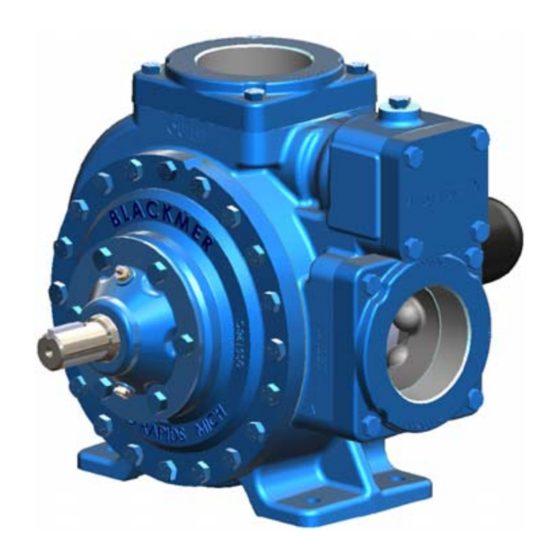Dover Blackmer LGL3021A Instructions d'installation, d'utilisation et d'entretien - Page 12
Parcourez en ligne ou téléchargez le pdf Instructions d'installation, d'utilisation et d'entretien pour {nom_de_la_catégorie} Dover Blackmer LGL3021A. Dover Blackmer LGL3021A 12 pages. Liquefied gas pumps

SYMPTOM
Reduced Capacity
Noise
Damaged Vanes
Broken Shaft
Mechanical Seal Leakage
Overload on Motor
Visit www.blackmer.com for complete information on all Blackmer products
TROUBLESHOOTING - continued
PROBABLE CAUSE
1.
Pump speed too low.
2.
Internal control valve not fully open.
3.
Excessive restriction in the inlet line (i.e.: undersized piping, too many elbows & fittings,
clogged strainer, etc.).
4.
Damaged or worn parts (vanes, cylinder, or rotor).
5.
Excessive restriction in discharge line causing partial flow through the relief valve.
6.
Relief Valve worn, set too low, or not seating properly.
7.
External Bypass Valve set too low.
8.
Operating without a vapor return line.
9.
Vanes installed incorrectly (see "Vane Replacement").
10. Liner installed backwards.
1. Excessive pressure drop on the pump due to:
a.
Undersized or restricted fittings in the inlet line.
b.
Pump speed too fast.
c.
Pump too far from fluid source.
2. Running the pump for extended periods with a closed discharge line.
3. Pump not securely mounted.
4. Improper drive line – truck mounted pumps (See "Pump Drive").
5. Misalignment of pump, reducer, or motor - base mounted pumps.
6. Bearings worn or damaged.
7. Vibration from improperly anchored piping.
8. Bent shaft, or drive coupling misaligned.
9. Excessively worn rotor.
10. Malfunctioning valve in the system.
11. Relief valve setting too low.
12. Liner installed backwards.
13. Damaged vanes (see following category).
1. Foreign objects entering the pump.
2. Running the pump dry for extended periods of time.
3. Cavitation.
4. Excessive heat.
5. Worn or bent push rods, or worn push rod holes.
6. Hydraulic hammer - pressure spikes.
7. Vanes installed incorrectly (see "Vane Replacement").
8. Incompatibility with the liquids pumped.
1. Foreign objects entering the pump.
2. Relief valve not opening.
3. Hydraulic hammer - pressure spikes.
4. Pump/driver, driveline/drive shaft misalignment.
5. Excessively worn vanes or vane slots.
1. O-rings not compatible with the liquids pumped.
2. O-rings nicked, cut or twisted.
3. Shaft at seal area damaged, worn or dirty.
4. Bearings overgreased.
5. Excessive cavitation.
6. Mechanical seal faces cracked, scratched, pitted or dirty.
1. Motor Horsepower not sufficient for application.
2. Improper wiring and/or low voltage to motor.
3. Misalignment
4. Excessive pressure or speed.
5. Bearing locknuts adjusted improperly.
6. Faulty or worn bearings.
7. Rotor rubbing against discs or liner.
8. Dirty mechanical seal faces.
1809 Century Avenue, Grand Rapids, Michigan 49503-1530 U.S.A.
Telephone: (616) 241-1611 • Fax: (616) 241-3752
E-mail: [email protected] • Internet Address: www .blackmer.com
